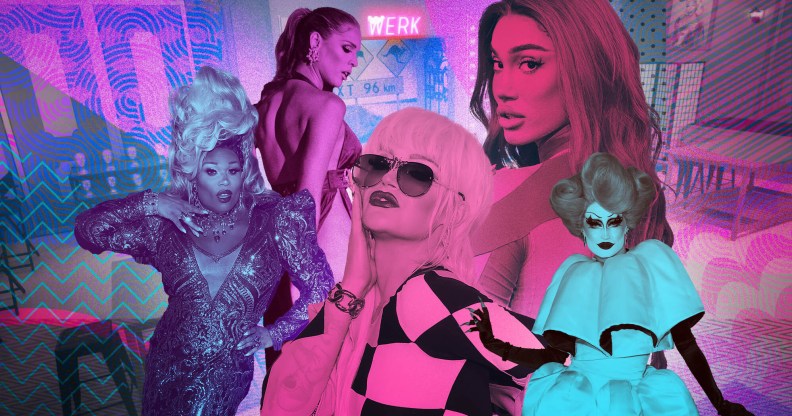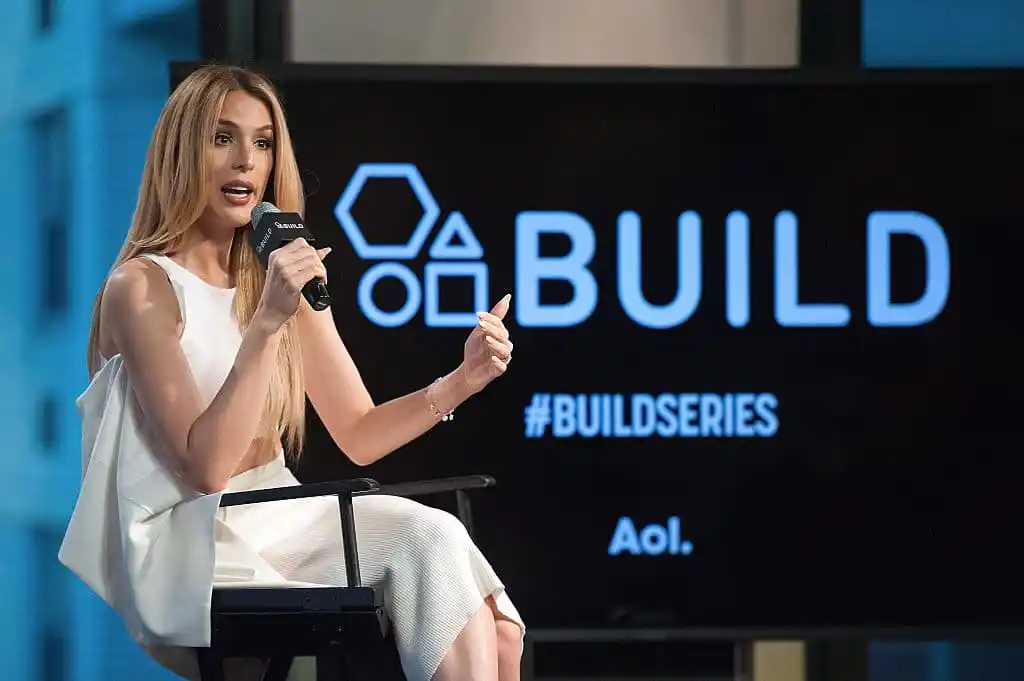From Carmen Carrera to Sasha Colby: How RuPaul’s Drag Race became a beacon for trans visibility

Charting Drag Race’s contentious relationship with trans contestants – from exclusionary to celebratory (Getty Images/ World of Wonder)
RuPaul’s Drag Race has had a turbulent relationship with trans performers over the years. This is the story of how the reality show confronted its exclusionary ideas about drag and welcomed in a new era of inclusivity.
When Carmen Carrera appeared on the third season of RuPaul’s Drag Race in 2011, the show was a world away from the polished chrome statuette we see on our screens today. The queens were unfiltered, the runway looks were rough around the edges, and Santino Rice was still on the judging panel. Beyond the usuals dramas of the Werk Room, though, there existed a bubbling undercurrent of exclusionary ideas about transgender and non-binary people.
Looking back upon the early seasons of Drag Race, RuPaul’s “You’ve got She-Mail!” catchphrase and use of offensive language in songs such as “Tr*nny Chaser” and “Lady Boy” in the mid-2000s make for uncomfortable viewing today.
But if the transphobia leaves us uneasy, it must have been considerably worse for Carrera. Shortly after leaving the show, the queen revealed that she identified as trans and had begun her transition “literally the day after” she finished filming.
It was from here that things started to get messy.
Carmen Carrera, the show’s first critic
In 2012, pop star Lance Bass issued an apology for using the word “tr*nny,” citing its use on Drag Race in defence, even though RuPaul was openly annoyed that the former Nsync singer did so. “I love the word ‘tr*nny’,” he insisted. “And no one has ever said the word ‘tr*nny’ in a derogatory sense.”
Then, in a 2014 Facebook post, Carrera criticised the show for its inclusion of transphobic slurs.
“Shemale is an incredibly offensive term, and this whole business about if you can tell whether a woman is biological or not is getting kind of old,” she wrote. “We live in a new world where understanding and acceptance are on the rise. Drag Race should be a little smarter about the terms they use.”
There was no public response from RuPaul’s side of the court. But if there’s one thing the world’s most famous drag queen doesn’t take well, it’s criticism.

Seasons 4-8: A tense tolerance
While Drag Race wasn’t a safe place for contestants to express their gender identity in the early years, performers such as Jiggly Caliente, Honey Mahogany and Gia Gunn, who would later come out as trans, continued to compete on the show.
While Kylie Sonique Love came out as a trans woman during the season two reunion of RuPaul’s Drag Race, it was Monica Beverly Hillz who made an indelible mark on Drag Race herstory in 2013 by becoming the first contestant to do so on the main stage.
In an emotional speech during the season five finale, the queen highlighted the difference between being a trans woman and a drag queen. “Drag is what I do, trans is who I am”, she declared.
Despite growing visibility, there remained a tense “tolerance” of trans performers on Drag Race, with a consensus among viewers that representation was permitted so long as trans queens didn’t overshadow the show itself.
Cynical viewers might note that Monica Beverly Hillz was eliminated in the episode following her coming out story, and read into RuPaul’s apparent annoyance that the network cut the “She-Mail” message for the seventh season; in an interview with Vulture, the host said that the decision “had nothing to do with [him]”.
“We do take feelings seriously and intention seriously,” RuPaul emphasised. “[But] if you are trigger-happy and you’re looking for a reason to reinforce your own victimhood, your own perception of yourself as a victim, you’ll look for anything that will reinforce that.”
Peppermint and RuPaul
Beloved season nine queen Peppermint was the first contestant to enter the Werk Room doors openly identifying as trans, even though she was yet to begin gender-affirming treatment. But speaking to The Guardian in 2018, RuPaul said that he “probably” would not have admitted someone onto the show had they started “changing their body”.
“You can identify as a woman and say you’re transitioning, but it changes once you start changing your body,” he said. “It takes on a different thing, it changes the whole concept of what we’re doing.”
But after sparking backlash from fans and former contestants, RuPaul doubled down on his views. “You can take performance-enhancing drugs and still be an athlete, just not in the Olympics”, he tweeted, which only served to further anger and isolate Drag Race alumni.
“We work with trans women every night, side by side, and for them to be denied the opportunities because of someone’s narrow-minded view on what they call ‘drag’ is f**ked,” wrote Drag Race firebrand Willam in a furious Instagram post.
This marked a turning point for RuPaul, who issued a rare, although now-deleted, apology to the trans community less than seven hours after firing off his controversial tweet.
“I understand and regret the hurt I have caused,” he wrote. “The trans community are heroes of our shared LGBTQ movement. You are my teachers.”
Peppermint called the apology an important step, emphasising that “women should not be defined by what surgeries they have or haven’t had” and “gay men do not own the idea of gender performance”.
Seasons 10-13, The Dawn of Gottmik
Despite this apology, not much changed for trans representation on Drag Race. Aquaria (2018), Yvie Oddly (2019) and Jaida Essence Hall (2020) all accepted the title of the ‘Next Drag Superstar’ without a trans contestant competing on their respective seasons.
Much life before, contestants continued to come out after their time on the main stage: Gigi Goode did so after making the top three in season 12. And Drag Race still attracted condemnation from fans, trans performers and former stars for its dire lack of trans visibility, while stars such as Detox even called out the show for “feigned inclusivity”. Carrera even compared RuPaul to Hitler.
In 2018, Gia Gunn returned to the Drag Race fold for All Stars 4, becoming was the first queen to walk back into the Werk Room having physically transitioned, although many believed the queen was painted in a negative light by the show’s edit.
It would take until 2021, though, for the first trans man to appear on Drag Race when Gottmik joined the cast of season 13. Not only had the performer begun his physical transition, but he openly discussed his gender journey on the show, making frequent references to hormone treatment and conflicts around gender presentation.
It was a groundbreaking moment for Drag Race, and fans reacted joyfully to the performer’s casting and success during the season.
RuPaul seemed to be learning too. Although he denied being involved in the axing of “she-male”, it’s doubtful that replacing the catchphrase “Gentlemen, start your engines, and may the best woman win” with “Racers, start your engines, and may the best drag queen win,” which occurred in season 13, could have been passed without the host’s seal of approval.
The renaissance of Kylie Sonique Love
Despite increasing representation, the show was still yet to step forward and unapologetically celebrate trans contestants. It would take the arrival of Kylie Sonique Love in the cast of All Stars 6 in 2021 to cross the final threshold.
Initially, reactions to the cast were mixed. With 13 contestants, it was notably larger than usual; but more importantly, it featured two openly trans women, Jiggly Caliente and Kylie Sonique Love, who had first appeared on the second season of Drag Race in 2010. Despite being a fan favourite, it would take her 11 years to return to the show with the now-iconic entrance tagline: “You’ve got female.”
Not only did Kylie Sonique Love become the first trans Drag Race contestant to snatch the crown, but fans were heartened to see her reappear in the Werk Room more confident and happy than ever, offering a true Drag Race “Rudemption” arc and golden proof of the joys of living authentically.
The Colby dynasty
Then came season 14. From the moment the cast was announced, fans were clamouring to see the first out, trans woman, Kerri Colby, make her grand entrance in the Werk Room.
Introduced as the daughter of legendary drag queen Sasha Colby, Kerri won viewers’ hearts with her warmth and kindness, and paved the way for further four contestants to come out as trans during or after the season.
Miss Congeniality Kornbread came out publically after filming (although she had started transitioning beforehand) and finalist Bosco did the same. Season winner Willow Pill discussed her gender identity on an episode of Untucked, and came out “officially” as trans femme during the week it aired.
In one of the season’s most heart-wrenching moments, Jasmine Kennedie came out to the rest of the queens in Untucked. Not only was the conversation was afforded breathing room and an appropriate level of respect and sensitivity, but it provided an opportunity for Drag Race to affirm its support for trans contestants past, present and future.
One of those future contestants was Sasha Colby, who has become a frontrunner during season 15 with three spectacular wins, and has not only shown the world the beauty of drag as an art form, but more importantly, the joy of trans existence.
As Drag Race continues its upwards trajectory with trans representation and inclusion, we’ve even reached the stage where RuPaul has now spoken up against Republican lawmakers pushing drag bans and anti-trans healthcare bills – a far cry from the queen who once made use of transphobic slurs all those years ago.
In an age where each day brings a fresh wave of hateful legislation and divisive rhetoric aimed at the LGBTQ+ community, Colby scooping the crown on one one of the most prolific competition series around the globe would send a powerful message: Drag Race stands in support of trans people, and the revolution is coming.

